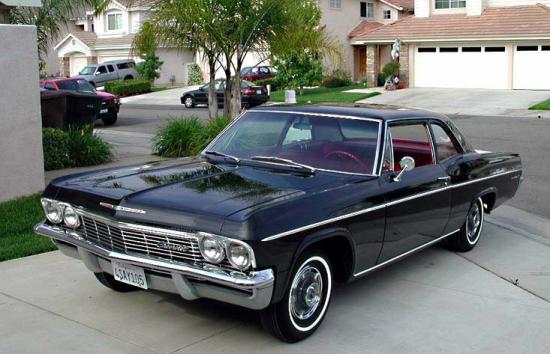@fastestlaps please delete the performance

Chevrolet Bel Air 396 SS specs
| Car type | Coupe |
| Curb weight | 1757 kg (3874 lbs) |
| Dimensions | 5.41 m (213 in) long, 2.02 m (80 in) wide, 1.41 m (55 in) high |
| Wheelbase | 3.02 m (119 in) |
| Introduced | 1965 |
| Origin country | United States |
| Views | 11.4k |
| Submitted by | Super8 |
Powertrain specs
| Engine type | GM Chevrolet Big-Block V-8 396 |
| Displacement | 6.5 l (396 ci / 6489 cc) |
| Power | 431 ps (425 bhp / 317 kw) @ 6400 rpm |
| Torque | 563 Nm (415 lb-ft) @ 4000 rpm |
| Power / liter | 66 ps (65 hp) |
| Power / weight | 245 ps (242 bhp) / t |
| Torque / weight | 320 Nm (236 lb-ft) / t |
| Transmission | 4 Speed Manual (3.31 ratio) |
| Layout | front engine, rear wheel drive |
Bel Air 396 SS competition
Super8 12y ago
Yes this is was tuned by Chevy. You might want to look the usual source: http://www.automobile-catalog.com/
Section Chevrolet USA, full size 1965 and Bel Air 2 door
Viking 12y ago
As for comparing sixties gross hp numbers to modern net, the easiest way to think about it is this: take a modern engine to a tuner, have it balanced and blueprinted, put tuned headers and straight exhaust on it, cold air intake, computer tune, replace hydraulic accessories with electric, and then run it in a carefully air conditioned room on an engine dyno. The result is the gross horsepower of that modern engine.
Viking 12y ago
Engines with hydraulic lifters usually experienced valve float before they reached 6000 rpm, but solid lifter engines with stiff valve springs like the 396 could rev well above their horsepower peak. Small block engines with their shorter strokes could frequently rev high as well, but most didn't breath efficiently enough to take advantage of the revs. The Chevy LT-1, and Ford's 351 Cleveland engines (and some others) did have efficient high rpm breathing however.
Viking 12y ago
If you rev an unmodified 396 with its 3.76 inch stroke to 7400 rpm you will throw a rod, too much piston speed. Chevy big blocks were the highest revving big blocks, but the peak power was at 5600 rpm and at the 6200 rev limit it had already fallen past its peak. Metallurgy was better than the fifties at least, and so newer engines could rev past 5000 rpm without valve float. NASCAR teams got special over the counter parts, and used blueprinting and tuning to reach 7000 rpm for the speedways. Chevy 396, 427, and 454 engines were some of the few capable of safely going over 6000 rpm in the sixties. I have lots of period info regarding engine technology from the fifties and sixties. However I do admit that if one re-builds one of these engines with modern parts you can increase the rev range significantly.